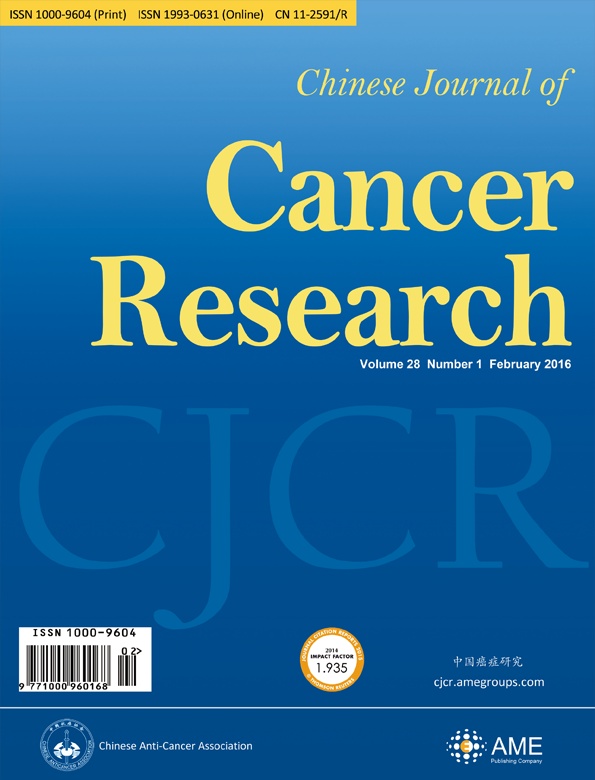淋巴血管浸润对胃癌患者术后总生存的预后意义
IF 7
2区 医学
Q1 ONCOLOGY
引用次数: 13
摘要
目的胃癌(GC)标本中常可见淋巴血管浸润(LVI)。研究表明,有LVI的GC患者预后比无LVI的GC患者差。方法回顾性分析天津医科大学肿瘤研究所附属医院胃癌科1007例根治性胃癌患者。根据LVI状态将患者分为两组:阳性组(PG);LVI的存在)和阴性组(NG;LVI缺失)。分析LVI校正后的临床病理因素及预后因素。此外,我们还提出了一种病理淋巴血管结(lvN)分类系统,以评估其与第八版N分期系统相比预测GC患者预后的优越性。结果LVI患者224例,占22.2%。浸润深度和淋巴结转移与LVI的存在独立相关。合并LVI的GC患者的总生存率(OS)明显低于未合并LVI的患者(分别为42.8%和68.9%;P < 0.001)。在多变量分析中,LVI被确定为胃癌患者的独立预后因素(危险比:1.370;95%置信区间:1.094−1.717;P = 0.006)。通过分层分析,仅在I - IIIa期或N0 - 2期患者中观察到两组之间的显著预后差异。我们发现lvN分级比pN分级系统更适合预测GC术后患者的OS。lvN分类的- 2对数似然值(4,746.922)小于pN的值(4,765.196),差异有统计学意义(χ2=18.434, P<0.001)。结论LVI的存在影响I - IIIa期和N0 - 2期胃癌患者的OS。应将LVI纳入pN分期系统,以提高GC患者预后预测的准确性。本文章由计算机程序翻译,如有差异,请以英文原文为准。
Prognostic significance of lymphovascular infiltration in overall survival of gastric cancer patients after surgery with curative intent
Objective Lymphovascular infiltration (LVI) is frequently detected in gastric cancer (GC) specimens. Studies have revealed that GC patients with LVI have a poorer prognosis than those without LVI. Methods In total, 1,007 patients with curatively resected GC at Department of Gastric Cancer, Tianjin Medical University Cancer Institute and Hospital were retrospectively enrolled. The patients were categorized into two groups based on the LVI status: a positive group (PG; presence of LVI) and a negative group (NG; absence of LVI). The clinicopathological factors corrected with LVI and prognostic variables were analyzed. Additionally, a pathological lymphovascular-node (lvN) classification system was proposed to evaluate the superiority of its prognostic prediction of GC patients compared with that of the eighth edition of the N staging system. Results Two hundred twenty-four patients (22.2%) had LVI. The depth of invasion and lymph node metastasis were independently associated with the presence of LVI. GC patients with LVI demonstrated a significantly lower overall survival (OS) rate than those without LVI (42.8% vs. 68.9%, respectively; P<0.001). In multivariate analysis, LVI was identified as an independent prognostic factor for GC patients (hazard ratio: 1.370; 95% confidence interval: 1.094−1.717; P=0.006). Using strata analysis, significant prognostic differences between the groups were only observed in patients at stage I−IIIa or N0−2. The lvN classification was found to be more appropriate to predict the OS of GC patients after curative surgery than the pN staging system. The −2 log-likelihood of lvN classification (4,746.922) was smaller than the value of pN (4,765.196), and the difference was statistically significant (χ2=18.434, P<0.001). Conclusions The presence of LVI influences the OS of GC patients at stage I−IIIa or N0−2. LVI should be incorporated into the pN staging system to enhance the accuracy of the prognostic prediction of GC patients.
求助全文
通过发布文献求助,成功后即可免费获取论文全文。
去求助
来源期刊
自引率
9.80%
发文量
1726
审稿时长
4.5 months
期刊介绍:
Chinese Journal of Cancer Research (CJCR; Print ISSN: 1000-9604; Online ISSN:1993-0631) is published by AME Publishing Company in association with Chinese Anti-Cancer Association.It was launched in March 1995 as a quarterly publication and is now published bi-monthly since February 2013.
CJCR is published bi-monthly in English, and is an international journal devoted to the life sciences and medical sciences. It publishes peer-reviewed original articles of basic investigations and clinical observations, reviews and brief communications providing a forum for the recent experimental and clinical advances in cancer research. This journal is indexed in Science Citation Index Expanded (SCIE), PubMed/PubMed Central (PMC), Scopus, SciSearch, Chemistry Abstracts (CA), the Excerpta Medica/EMBASE, Chinainfo, CNKI, CSCI, etc.

 求助内容:
求助内容: 应助结果提醒方式:
应助结果提醒方式:


